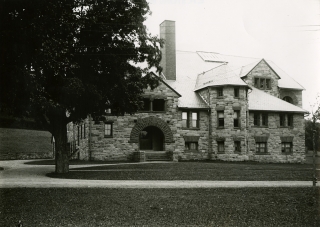natural philosophy to ecclesiastical and civil history, intellectual and moral philosophy, or theology, as the needs of the curriculum dictated; he seemed to be at home with each. His tall commanding figure, kind, demonstrative nature, gracious manner, and ready anecdote or biting sarcasm attracted and held attention. A clear memory and natural eloquence made him an apt and forceful speaker, while his facile pen gave his ideas expression equally vigorous.
Students liked to have Eaton speak at their gatherings. One of his best addresses, The Duty and Rewards of Original Thinking, he gave at a literary, society meeting in 1841. In a practical and forthright approach to his subject he urged the members to throwaway intellectual crutches and think “independently of direct aid from other minds.” Anyone resigning his thinking to “authorities,” Eaton felt, dishonored God and his own lofty nature as a rational being. The student whose compositions were mere compilations from books and lectures was “nothing more than a cistern, if not a broken one; for the contents which he has gathered from outward sources can be exhausted and leave him empty and dry…” Original intellectual activity, he maintained, yielded rich rewards in personal respect and dignity and in power over other men. Even today most of the address would be stimulating advice for a college community.
Stephen W. Taylor, who had distinguished himself by bringing order out of chaos in the Preparatory Department after his appointment as principal in 1834, succeeded Eaton as Professor of Mathematics and Natural Philosophy four years later. A native of Massachusetts and valedictorian, of the Class of 1817 at Hamilton College, he came to the Institution after several years’ experience as head of the Lowville Academy, Lowville, New York. By nature and inclination a poet, he suppressed his aesthetic tendencies in the interest of mathematics and science, fields which he thoroughly mastered. A born teacher, he had a way of dealing with boys by which he enforced discipline and yet at the same time retained their affection. One alumnus recalled:
I used to regard him as the most perfect model for young men forming a character, and I still think no one can imitate his regularity, promptness and rigid division & improvement of time without being a hundredfold better prepared for the stern duties of life….*
When he resigned in 1845 despite the unanimous wish of the Trustees,
*Ira, J. Stoddard, Nowgong, Assam, to Eastern Association, Aug. 11, 1851.





